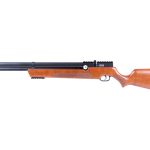PCP airguns are at the top of the airgun food chain. They deliver the most power, range, and accuracy and require the least amount of effort from the shooter. Simply put, they are awesome. Whether you are looking to plink silently in your basement or backyard or take big game out in the field, there’s an ideal PCP airgun to fit your needs and budget. But how do they work and are they sustainable for the long term? Let’s find out.
PCP Basics
PCP stands for “precharged pneumatic.” A lot of airgunners may have started with a low-powered spring gun like the Daisy Red Ryder, but their next airgun was probably a pump pneumatic like the Crosman 760 or the Daisy 880. These guns used compressed air stored in a small chamber. Shooters had to pump up this chamber between each shot. The benefit was a lot more power with little to no recoil. A PCP airgun follows this trend, but rather than having to pump up the airgun for each shot, the air chamber is much larger and filled to a much higher pressure. As long as there’s enough pressure and volume, PCP shooters can simply cock, load, and keep shooting.
PCP Components
Air Cylinder
All PCP airguns consist of a few key components. First, we have the air cylinder. The size and optimal pressure can vary depending on the airgun. An average size would be about 320 CCs filled to about 250 Bar, or about 3650 PSI +/-. Depending on the caliber and output power, this configuration could yield dozens of shots between fills.
The Valve
The most critical component on a PCP airgun is inevitably the valve. This device sits between the high-pressure air stored in the air chamber and the breech holding the projectile. It’s designed to deliver a relatively consistent charge of air pressure and volume to drive the pellet or slug downrange. Some airguns incorporate another layer to the valving system, which we’ll talk about next.
The Regulator
An old-school PCP had an air cylinder and a valve. But there’s a drawback. As air is released to drive pellets down the barrel, the pressure constantly decreases. This leads to shot-to-shot variance in velocity. It’s possible to achieve a reasonable balance, but shot count and accuracy are always left on the table. A regulator helps solve this. Here’s how.
A regulator acts as a “staging area” between the air cylinder and the valve. Let’s say you have 300CCs of air stored at 3000 PSI in your air cylinder, but you only need 25CCs at 1200 PSI to get optimal velocity from your airgun. The regulator is placed between the main air cylinder and the valve. With each shot, the regulator allows air to flow from the air cylinder to the plenum, filling to the desired volume and pressure for each shot. In this case, let’s say 1200 psi. When the valve is actuated, the charge from the plenum drives the pellet or slug down the barrel. As long as the pressure in the main air cylinder is higher than the regulator’s output pressure, each shot should be relatively consistent, delivering better shot count with much higher shot-to-shot consistency.
The Hammer and Hammer Spring
The last components we’ll examine today regarding their unique role in PCP airguns are the hammer and hammer spring. The hammer interacts with the valve, opening it and releasing the high-pressure air on the other side. How hard you hit the valve can determine how much air volume is released. The hammer spring, along with the hammer weight, determines the force hitting the valve. Some PCP airguns feature an adjustable hammer spring, allowing the shooter to dial how much energy is used to open the valve. Shooters can vary the output power of their PCP using this method.
That’s It For Now
We hope you all enjoyed that quick look at the basic mechanics of a PCP airgun. If you have more questions, please be sure to reach out. We are always happy to help.
